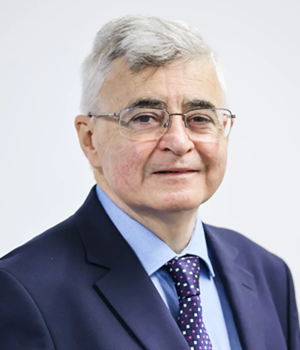Special Rapporteur on the Rights of Persons with Disabilities
Published online by Cambridge University Press: 18 October 2022

Gerard Quinn is the United Nations (UN) Special Rapporteur on the rights of persons with disabilities. A graduate of Harvard Law School, he founded and directed the Centre for Disability Law & Policy at the National University of Ireland for many years. He sat as a member of the Council of Europe's treaty body on social rights and served as a civil servant in the European Commission, where he drafted European Union disability policies. He has conducted many large studies for the UN, including a 2002 Study that helped launch the drafting of the UN Convention on the Rights of Persons with Disabilities. He led the delegation of Rehabilitation International during the drafting of the treaty. He has received many lifetime awards for his work on international disability law from the US International Council on Disability, the European Association of Service Providers for Persons with Disabilities and Rehabilitation International. He was conferred with an honorary doctorate for his worldwide disability law work by Lund University in 2022. He has held honorary positions at the National Academy of Legal Studies and Research (NALSAR; Hyderabad, India), Wuhan University (China), Fudan University (Shanghai), University of New South Wales (Sydney), Deakin University (Melbourne), Harvard Law School and Haifa University (Israel). He served on the Council of State in Ireland where he advised the President on constitutional law matters. His hobbies include folk music and storytelling.
This interview was conducted by Bruno Demeyere, Editor-in-Chief of the International Review of the Red Cross, on 23 August 2022.
The advice, opinions and statements contained in this article are those of the author/s and do not necessarily reflect the views of the ICRC. The ICRC does not necessarily represent or endorse the accuracy or reliability of any advice, opinion, statement or other information provided in this article.
1 For more information, see UN Department of Economic and Social Affairs, “Special Rapporteur 1994–2002: Bengt Lindqvist”, available at: www.un.org/development/desa/disabilities/about-us/history-of-disability-and-the-united-nations/special-rapporteur-1994-2002-bengt-lindqvist.html (all internet references were accessed in September 2022).
2 UN Convention on the Rights of People with Disabilities, Resolution A/RES/61/106, 13 December 2006 (entered into force 3 May 2008), available at: www.ohchr.org/en/instruments-mechanisms/instruments/convention-rights-persons-disabilities.
3 For more information, see Office of the High Commissioner for Human Rights, “Catalina Devandas Aguilar, Former Special Rapporteur (2014–2020): Special Rapporteur on the Rights of Persons with Disabilities”, available at: www.ohchr.org/en/special-procedures/sr-disability/catalina-devandas-aguilar-former-special-rapporteur-2014-2020.
4 Study Group of the International Law Commission, “Fragmentation of International Law: Difficulties Arising from the Diversification and Expansion of International Law”, 13 April 2006, available at: https://legal.un.org/ilc/documentation/english/a_cn4_l682.pdf.
5 Office of the High Commissioner for Human Rights, “A/76/146: Report on the Rights of Persons with Disabilities in the Context of Armed Conflict”, 19 July 2021, available at: www.ohchr.org/en/documents/thematic-reports/a76146-report-rights-persons-disabilities-context-armed-conflict.
6 Office of the High Commissioner for Human Rights, “A/77/203: Report on the Protection of the Rights of Persons with Disabilities in the Context of Military Operations”, 2 September 2022, available at: www.ohchr.org/en/documents/thematic-reports/a77203-report-protection-rights-persons-disabilities-context-military.
7 Geneva Convention (IV) relative to the Protection of Civilian Persons in Time of War of 12 August 1949, 75 UNTS 287 (entered into force 21 October 1950), available at: www.un.org/en/genocideprevention/documents/atrocity-crimes/Doc.33_GC-IV-EN.pdf.
8 For Article 11 of the CRPD, see UN Department of Economic and Social Affairs, “Article 11 – Situations of Risk and Humanitarian Emergencies”, available at: www.un.org/development/desa/disabilities/convention-on-the-rights-of-persons-with-disabilities/article-11-situations-of-risk-and-humanitarian-emergencies.html.
9 Office of the High Commissioner for Human Rights, above note 6.
10 Office of the High Commissioner for Human Rights, above note 5.
11 Office of the High Commissioner for Human Rights, “A/HRC/49/52: Artificial Intelligence and the Rights of Persons with Disabilities – Report of the Special Rapporteur on the Rights of Persons with Disabilities”, 28 December 2021, available at: www.ohchr.org/en/documents/thematic-reports/ahrc4952-artificial-intelligence-and-rights-persons-disabilities-report.
12 See Figueroa, Mariana Díaz, Orozco, Anderson Henao, Martínez, Jesús and Muñoz, Wanda, “The Risks of Autonomous Weapons: A Disability Rights Perspective”, in this issue of the International Review of the Red Cross, 2023Google Scholar.
13 UN Security Council, Resolution 2475 (2019), UN Doc. S/RES/2475 (2019), 20 June 2019, available at: http://unscr.com/en/resolutions/2475.